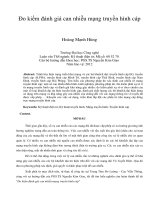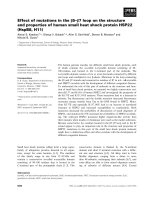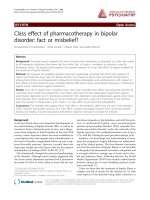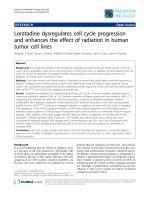Effect of phosphorus, zinc and iron on yield and quality of wheat in Western Rajasthan, India
Bạn đang xem bản rút gọn của tài liệu. Xem và tải ngay bản đầy đủ của tài liệu tại đây (309.09 KB, 8 trang )
Int.J.Curr.Microbiol.App.Sci (2018) 7(3): 2055-2062
International Journal of Current Microbiology and Applied Sciences
ISSN: 2319-7706 Volume 7 Number 03 (2018)
Journal homepage:
Original Research Article
/>
Effect of Phosphorus, Zinc and Iron on Yield and Quality of
Wheat in Western Rajasthan, India
Ram Chandar Jat, Yogesh Sharma, R.K. Jakhar* and R.K. Sharma
Department of Soil Science and Agricultural Chemistry, College of Agriculture, Swami
Keshwanad Rajasthan Agriculture University, Bikaner, India
*Corresponding author
ABSTRACT
Keywords
Phosphorus, Zinc,
Iron, Yield,
Chlorophyll
content, Protein
content, Wheat
Article Info
Accepted:
16 February 2018
Available Online:
10 March 2018
A field experiment was carried out during two consecutive rabi seasons of 2009-10 and
2010-11 at the Agronomy farm, College of Agriculture, Swami Keshwanand Rajasthan
Agricultural University, Bikaner to find out the effect of phosphorus, zinc and iron on
yield and quality of wheat (Triticum aestivum L.) in Loamy sand soils of Western
Rajasthan with ten treatments comprising 4 levels of phosphorus (0, 20, 40 and 60 kg ha -1)
and zinc (0, 3 and 6 kg ha-1) in main plots and 3 levels of iron (0, 3 and 6 kg ha-1) in splitplot design with three replications. Application of phosphorus up to 40 kg P 2O5 ha-1
significant]y increased the grain, straw and biological yields beyond which it increased
non-significantly and registered a mean increase of 26.2, 30.6 and 28.8 per cent,
respectively over control. Application of phosphorus @ 40 kg P 2O5 ha-1, 3 kg Zn ha-1 and
of 6 kg Fe ha-1 significantly increased the chlorophyll content of wheat at flowering stage
and protein content of grains in wheat during both the years of investigations and in pooled
analysis. Whereas, Application of higher doses of phosphorus, zinc and iron did not had
significant effect on total sugar content of grain and crude fibre content.
Introduction
Wheat [Triticum aestivum (L.)] is the second
most important food grain crop in India
ranking next to rice (Oryza sativa L.)
contributing about 35% of the food grain
production in India. India occupies second
position next to China in the World with
regard to area 30.96 million hectares and
production 88.94 million tones with average
productivity of 28.72 q ha-1 of wheat
(Anonymous, 2014-15). In India, main wheat
growing states are UP, Punjab, Haryana,
M.P., Rajasthan and Bihar. In Rajasthan,
wheat has an area of 2.94 million hectares
with the production of 9.86 million tonnes.
The average productivity of wheat in the state
is 33.65 q ha-1 (Anonymous, 2014-15). This
clearly indicates that in spite of considerable
improvement in genetic potential of the crop,
productivity is still very poor in the country as
well as in the state of Rajasthan. The high
2055
Int.J.Curr.Microbiol.App.Sci (2018) 7(3): 2055-2062
productivity of wheat can only be achieved by
the adoption of suitable variety and improved
agronomic practices with balanced and
judicious use of chemical fertilizers in an
integrated way.
Among the essential nutrients, phosphorus
occupies a key place in intensive agriculture
and is considered as a backbone of any
fertilizer
management
programme.
Application of phosphorus not only increases
the crop yield but also improves crop quality
and imparts resistance against diseases. It is
involved in wide range of plant processes as
permitting cell division, development of
sound root system and ensuring timely and
uniform ripening of crop. It participates in
metabolic activities as a constituent of
nucleoprotein and nucleotides and also plays
a key role in the formation of energy rich
bond phosphate like Adenosine diphosphate
and Adenosine triphosphate. It plays a vital
role in virtually every plant process like
photosynthesis, energy storage and transfer,
stimulating root development and growth,
giving plant rapid and vigorous start leading
to better tillering in wheat, encouraging
earlier maturity and seed formation.
Therefore, sufficient quantity of soluble form
of phosphorus fertilizers is applied to achieve
maximum plant productivity. However, the
applied soluble forms of phosphatic fertilizers
rapidly become unavailable to plants by
conversion into inorganic P fractions that are
fixed
by
chemical
adsorption
and
precipitation. Similarly, organic P fractions
are immobilized in soil organic matter
(Sanyal and De Dutta, 1991).
Micronutrients were first recognized as a
limiting factor in crop production in United
States in Florida during the 1920’s.
Micronutrients play a vital role in enhancing
crop
productivity.
Intensification
of
agriculture with high yielding varieties,
continuous use of high analysis fertilizers,
restricted supply of organic manures and
negligible crop residue return to soil led to
micronutrient deficiency. The overall
deficiency of micronutrient in Indian soil was
found to be 47 per cent for Zn, 2 per cent for
Cu, 13 per cent for Fe and 4 per cent for Mn
(Sakal and Singh, 2001). The present
investigation was carried out to evaluate and
describe the fertilizer phosphorus, zinc and
iron application on growth attributes and yield
attributes of wheat in Loamy sand soils of
Western Rajasthan.
Materials and Methods
The experiment was conducted at the
Agronomy farm, College of Agriculture,
Swami Keshwanand Rajasthan Agricultural
University, Bikaner during rabi seasons of
2009-10 and 2010-11. The experimental site
is located at 28.010N latitude and 73.220E
longitude at an altitude of 234.7m above
mean sea level and falls under Agroecological region No. 2 (M9E1) under Arid
ecosystem (Hot Arid Eco-region), which is
characterized by deep, sandy and coarse
loamy, desert soils with low water holding
capacity and hot and arid climate.
The soils of experimental field was loamy
sand in texture having pH -8.2, EC -0.22 dS
m-1, available N – 90.1 kg ha-1, available P2O5
– 14.2 kg ha-1, available K2O – 160.4 kg ha-1,
avalable Zinc- 0.34 mg kg-1, avalable iron2.90 mg kg-1 and organic carbon-0.15%.
The field experiment on wheat in rabi seasons
of 2009-10 and 2010-11 was laid out
comprising 4 levels of phosphorus (0, 20, 40
and 60 kg ha-1) and zinc (0, 3 and 6 kg ha-1) in
main plots and 3 levels of iron (0, 3 and 6 kg
ha-1) in sub plots. A total of 36 treatment
combinations were tested in split plot design
with three replications. The treatment details
are follows:
2056
Int.J.Curr.Microbiol.App.Sci (2018) 7(3): 2055-2062
following formula and expressed
percentage (Singh and Stoskoof, 1971).
(A) Main plot treatments
as
Phosphorus levels
P0 = Control, P1 = 20 Kg ha-1, P2 = 40 Kg ha-1
and P3 = 60 Kg ha-1
Zinc levels
Zn0 = Control, Zn1 = 3 Kg ha-1 and Zn2 = 6 Kg
ha-1
(B) Sub plot treatments
Iron levels
Fe0 = Control, Fe1 = 3 Kg ha-1 and Fe2 = 6 Kg
ha-1
-1
Nitrogen was applied @ 120 kg N ha was
applied RDF. Half dose was applied as basal
through urea after adjusting the quantity of N
supplied by DAP. Remaining half dose of N
was applied through broadcasting of urea in
two equal split doses just after irrigation at 25
and 75 DAS. Potassium was applied @20 kg
K2O ha-1 was applied through muriate of
potash
before
sowing.
Phosphorus:
Phosphorus was applied through DAP, zinc
was applied through zinc sulphate and iron
was applied through ferrous sulphate before
sowing as per treatment. Seeds were treated
with thiram (2 g kg-1 seed) as prophylactic
measures against seed borne diseases. The
wheat variety ‘Raj-3077’ was sown by “kera”
method at a depth of 5 cm in rows spaced at
22.5 cm apart on 25th and 28th November in
the years 2009-10 and 2010-11, respectively
using seed rate of 120 kg ha-1.
The grain yield of each net plot was recorded
in kg plot-1 after cleaning the threshed
produce and was converted as kg ha-1. Straw
yield was obtained by subtracting the grain
yield (kg ha-1) from biological yield (kg ha-1).
The harvest index was calculated by using
Harvest index (%) =
Economic yield
Biological yield
x 100
Fresh leaves collected at flowering stage from
each plot were washed twice with water and
once with distilled water. Treatment wise
fresh leaf sample of 0.1 g was taken and
ground in 80 per cent acetone, filtered from
filter paper No. 42 and volume was made upto
25 ml. The resultant intensity of colour was
measured in UV-VIS spectrophotometer 118
(systronics) at specific wave length (645 m
and 663 m) to estimate chlorophyll ‘a’ and
chlorophyll ‘b’ content (Arnon, 1949).
Chlorophyll ‘a’ content (mg g-1) =
12.7 A663 – 2.69 A645
xV
a x 1000 x w
Chlorophyll ‘b’ content (mg g-1) =
22.9 A645 – 4.68 A663
xV
a x 1000 x w
Where,
a = Length of light path in cell (usually 1 cm)
w = Fresh weight of leaf samples (g)
v = Volume of extract (ml)
Total chlorophyll content (mg g-1) =
Chlorophyll ‘a’ + Chlorophyll ‘b’
The protein content in grain was calculated by
multiplying per cent nitrogen content with a
factor of 6.25 (A.O.A.C., 1970). The sugar
content was determined by the method
described by AOAC (1970). The crude fiber
content was calculated by using following
formula and expressed in percentage as
described by AOAC (1970).
2057
Int.J.Curr.Microbiol.App.Sci (2018) 7(3): 2055-2062
Crude fiber (%) =
Weight of residue – Weight of ash
________________________________________
x 100
Amount of substance taken
Results and Discussion
Effect of phosphorus
Application of phosphorus at 40 kg P2O5 ha-1
significantly increased the grain yield, straw
yield and biological yield over control during
both year of experimentation and pooled
analysis (Table 1). The significant increase in
grain yield of wheat due to application of
phosphorus up to 40 kg P205 ha-1 was largely a
function of improved growth and the
consequent increase in different yield
attributes. The grain yield of wheat increased
by 762 kg ha-1 due to application of 40 kg
P2O5 ha-1 over control. Jain and Dahama
(2006) and Jat et al., (2007) also recorded
significant improvement in wheat grain yield
with increase in phosphorus levels. The
significant increase in straw yield due to
application of phosphorus could be attributed
to the increased vegetative growth as evident
from dry matter production and CGR possibly
as a result of the effective uptake and
utilization of nutrients absorbed through its
extensive root system developed under
phosphorus fertilization (Rathi and Singh,
1976).
The biological yield is a function of grain and
straw yields. Thus, significant increase in
biological yield with the application of
phosphorus could be ascribed to the increased
grain and straw yields. The faster rate of
improvement in grain yield as compared to
straw yield to phosphorus fertilization led to
significant improvement in biological yield
thereby suggesting better source and sink
relationship. These results are in conformity
with those of Jat et al., (2007) and Sepat and
Rai (2013).
Data perusal in Table 2 revealed that
application of phosphorus @ 40 kg P2O5 ha-1
significantly increased the chlorophyll content
of wheat at flowering stage during both the
years of investigations and in pooled analysis.
This may be attributed to increased N content
in grain and its uptake by the crop and role of
P in energy conservation and transformation.
Higher nitrogen content in grain due to P
fertilization resulted in higher crude protein
content as nitrogen is an integral part of
protein. Such increase in protein content is
due to the reduction of nitrates to ammonia by
the activities of complex enzymes resulting in
production of more amino acids, which are
main constituents of protein. These results are
corroborates with the findings of Azad et al.,
(2010) and Pingoliya et al., (2015).
Effect of zinc
Application of zinc at 3 kg ha-1 significantly
increased the number of yield of wheat over
control during both the years (Table 1). The
increase in the yield due to zinc application
may be attributed to the fact that the initial
status of available zinc in the experimental
soil was low. The increase in yield attributes
may be due to increased supply of available
zinc to plants by way of its addition to soil
which resulted in proper growth and
development. The increase in the yield
attributes might be due to role of zinc in
biosynthesis of indole acetic acid (IAA) and
especially due to its role in initiation of
primordia for reproductive parts and
partitioning of photosynthates towards them,
which resulted in better flowering and
fruiting. The significant increase in straw
yield due to zinc fertilization could be
attributed to the increased plant growth and
biomass production, possibly as a result of the
uptake of nutrients. Similar results were
reported by Singh et al., (2015) and Arshad et
al., (2016).
2058
Int.J.Curr.Microbiol.App.Sci (2018) 7(3): 2055-2062
Table.1 Effect of phosphorus, zinc and iron on yield (kg ha-1) and harvest index of wheat
Grain yield kg ha-1
Straw yield kg ha-1
Biological yield kg ha-1
Harvest index
2009-10 2010-11 Pooled 2009-10 2010-11 Pooled 2009-10 2010-11 Pooled 2009-10 2010-11 Pooled
Phosphorus levels (P2O5 Kg ha-1)
2815
2986
2901
4176
4208
4192
6990
7195
7093
39.23
40.79
40.01
Control
3329
3503
3416
4854
5097
4975
8184
8600
8392
40.80
41.24
41.02
20
3584
3743
3663
5396
5557
5476
8980
9300
9140
39.94
40.24
40.09
40
3644
3826
3735
5544
5641
5593
9195
9467
9331
39.81
40.39
40.10
60
51
50
36
72
66
49
121
105
80
0.92
0.59
0.55
SEm±
149
146
101
210
193
138
354
307
228
NS
NS
NS
CD
(P=0.05)
Zinc levels (Zn Kg ha-1)
3049
3205
3127
4636
4829
4733
7685
8034
7860
38.94
39.48
39.21
Control
3453
3625
3539
5105
5235
5170
8557
8860
8709
40.43
41.12
40.77
3
3527
3714
3620
5236
5313
5275
8769
9027
8898
40.47
41.40
40.93
6
44
43
31
62
57
42
105
91
69
0.80
0.51
0.47
SEm±
129
127
88
182
167
120
307
266
197
NS
NS
NS
CD
(P=0.05)
Iron levels (Fe Kg ha-1)
3032
3187
3109
4560
4756
4658
7597
7944
7771
39.27
39.66
39.47
Control
3451
3624
3538
5136
5267
5202
8588
8891
8739
40.27
40.94
40.60
3
3546
3733
3640
5281
5354
5317
8827
9087
8957
40.30
41.39
40.85
6
52
55
38
59
61
43
117
105
78
0.82
0.60
0.51
SEm±
149
158
107
169
173
119
332
298
220
NS
NS
NS
CD
(P=0.05)
Treatments
2059
Int.J.Curr.Microbiol.App.Sci (2018) 7(3): 2055-2062
Table.2 Effect of phosphorus, zinc and iron on quality parameters of wheat
Treatments
Chlorophyll content
(mg g-1 of fresh leaves)
20092010Poole
10
11
d
-1
Phosphorus levels (P2O5 Kg ha )
2.17
Control
2.61
20
2.78
40
2.87
60
0.06
SEm±
0.18
CD (P=0.05)
Zinc levels (Zn Kg ha-1)
2.29
Control
2.72
3
2.81
6
0.05
SEm±
0.16
CD (P=0.05)
Iron levels (Fe Kg ha-1)
2.31
Control
2.68
3
2.84
6
0.04
SEm±
0.11
CD (P=0.05)
Protein content
of grain (%)
2009-10 2010-11 Poole
d
Total sugar content
of grain (%)
2009-10 2010Poole
11
d
Crude fiber content
of grain (%)
2009-10 2010-11 Pooled
2.22
2.66
2.85
2.92
0.05
0.14
2.19
2.64
2.82
2.90
0.04
0.11
8.91
9.67
10.17
10.29
0.10
0.28
8.74
9.82
10.07
10.28
0.14
0.42
8.83
9.74
10.12
10.29
0.09
0.25
10.92
10.94
11.03
11.07
0.30
NS
10.67
11.05
11.07
11.31
0.21
NS
10.79
11.00
11.05
11.19
0.18
NS
32.17
31.60
31.26
31.17
0.40
NS
32.00
31.66
31.18
30.71
0.45
NS
32.08
31.63
31.22
30.94
0.30
NS
2.34
2.79
2.86
0.04
0.12
2.31
2.76
2.84
0.03
0.10
9.40
9.87
10.01
0.08
0.25
9.38
9.83
9.98
0.12
0.37
9.39
9.85
9.99
0.08
0.21
10.94
10.97
11.07
0.26
NS
10.86
11.06
11.16
0.19
NS
10.90
11.01
11.11
0.16
NS
31.71
31.63
31.32
0.34
NS
31.52
31.46
31.18
0.39
NS
31.61
31.54
31.25
0.26
NS
2.37
2.74
2.89
0.03
0.09
2.34
2.71
2.86
0.02
0.07
9.42
9.87
9.99
0.12
0.35
9.40
9.75
10.04
0.13
0.36
9.41
9.81
10.01
0.09
0.25
10.77
11.06
11.15
0.22
NS
10.74
11.16
11.19
0.15
NS
10.75
11.11
11.17
0.13
NS
31.63
31.54
31.49
0.28
NS
31.44
31.36
31.36
0.28
NS
31.53
31.45
31.42
0.20
NS
2060
Int.J.Curr.Microbiol.App.Sci (2018) 7(3): 2055-2062
Application of zinc @ 3 kg ha-1 significantly
increased the chlorophyll content of wheat at
flowering stage during both the years of study
as well as on pooled basis. Experimental
results also showed a significant increase in
protein content in grain of wheat due to the
application of zinc up to 3 kg ha-1.
Application of zinc in soil increased the
availability of zinc in the rhizosphere. The
role of zinc in increasing the metabolic and
physiological activity of the plants is of great
significance as it influences the activities of
hydrogenase and carbonic anhydrase,
stabilization of ribosomal fractions and
synthesis of cytochrome (Tisdale et al., 1984).
Similar results were also been reported by
Shivay et al., (2014) and Paramesh et al.,
(2014).
Effect of iron
Application of 3 kg Fe ha-1 significantly
increased the grain yield (Table 1) over
control but it was found statistically at par
with 3 kg Fe ha-1. An increase in grain yield
may be attributed to the significant increase in
number of effective tiller per plant and
number of grains per ear. Further, increase in
grain yield due to iron application in the soil
could possibly be due to the enhanced
metabolites of carbohydrates and protein and
their transport to the site of grain production.
Since iron is a constituent of ferrodoxin and
cytochromes,
which
involved
in
photosynthesis, the increase in iron supply
could result in enhanced synthesis of
carbohydrates. Similarly, significant increase
in straw yield was recorded with the
application of 3 kg Fe ha-1. This might be due
to increased crop growth and development
viz. dry matter accumulation and yield
attributes of plants under better nutritional
environment, under the application of iron.
Significant increase in grain and straw yield
due to iron application has also been reported
by Habib (2009). The biological yield is a
function of grain and straw yields. Thus,
increase in biological yield with the
application of iron could be ascribed to
increase grain and straw yields. These results
are in line conformity of findings of Gill and
Walia (2014).
Application of iron @ 6 kg ha-1 significantly
increased the chlorophyll content of wheat at
flowering stage during both the years of study
as well as on pooled basis. Application of Fe
@ 6 kg ha-1 significantly increased mean
chlorophyll content by 22.20 per cent and
5.77 per cent over control and 3 kg Fe ha-1,
respectively. Data perusal in table 2 revealed
that application of Fe @ 6 kg ha-1
significantly increased mean chlorophyll
content by 22.20 per cent and 5.77 per cent
over control and 3 kg Fe ha-1, respectively.
Whereas, application of iron @ 3 kg ha-1
increased the protein content of wheat
significantly during both the years of
experimentation as well as in the pooled
analysis. However, total sugar content of
grain and crude fiber content of grain did not
affected significantly during both the years of
study as well as in the pooled analysis. Iron
might have helped in greater nitrogen uptake
by plant and translocation in various plant
parts including grain. Since nitrogen is
essential constitute of protein, increased
nitrogen content led to higher protein content.
These results corroborative with the findings
of Pingoliya et al., (2015).
References
Anonymous 2014-15. Economic survey of India,
Ministry of Finance (Economic Division)
GOI, New Delhi.
AOAC 1970. Official methods of analysis. 9th
edition
Association
of
Official
Agricultural Chemists, Washington DC.
Pp-119.
Arnon DI 1949. Copper enzyme in isolated
chloroplast polyphenoxidase in Beta
vulgaris. Plant Physiology, 24: 1-15.
2061
Int.J.Curr.Microbiol.App.Sci (2018) 7(3): 2055-2062
Arshad M, Adnan M, Ahmed S, Khan AK, Ali I,
Ali M, Ali A, Khan A, Kamal MA and
Gul F 2016. Integrated Effect of
Phosphorus and Zinc on Wheat Crop.
American-Eurasian
Journal
of
Agriculture & Environmental Science,
16 (3): 455-459.
Azad VB, Bali BS and Saha AAS 2010. Effect
of phosphorus levels and biofertilizers on
yield, P-uptake and economics of wheat
(Triticum aestivum). Environment and
Ecology, 28: (1B): 534-537.
Gill JS and Walia SS 2014. Effect of foliar
application of iron, zinc and manganese
on direct seeded aromatic rice (Oryza
sativa). Indian Journal of Agronomy, 59
(1): 80-85.
Habib M 2009. Effect of foliar application of Zn
and Fe on wheat yield and quality.
African Journal of Biotechnology, 8 (24):
6795-6798.
Jain NK and Dahama AK 2006. Direct and
residual effects of phosphorus and zinc
fertilization on productivity of wheat
(Triticum aestivum) - pearl millet
(Pennisetum glaucum) cropping system.
Indian journal of Agronomy, 51: 165169.
Jat BL, Shaktawat MS and Jat AS 2007. Effects
of phosphorus levels alone or in
combination with phosphate-solubilizing
bacteria (Pseudomonas striata) and
farmyard manure on growth, yield and
nutrient uptake of wheat (Triticum
aestivum). Journal of Agriculture and
Social Sciences, 32: 78-82
Paramesh V, Dhar S, Vyas AK and Dass, A
2014.
Studies
on
impact
of
phosphoenriched compost, chemical
fertilizer and method of zinc application
on yield, uptake and quality of maize
(Zea mays). Indian Journal of
Agronomy, 59 (4): 613-618.
How to cite this article:
Pingoliya KK, Mathur AK, Dotaniya ML and
Dotaniya CK 2015. Impact of
phosphorus and iron on protein and
chlorophyll content in chickpea (Cicer
arietinum L.). Legume Research, 38 (4):
558-560.
Rathi SS and Singh D 1976. Effect of nitrogen
and phosphate fertilization on the growth
and yield of gram. Indian Journal of
Agronomy, 21(3): 305-306.
Sakal R and Singh AP 2001. Micronutrient in
relation to response and quality of crop.
Journal of Agricultural Chemistry, 14: 45.
Sanyal SK and De Datta SK 1991. Chemistry of
phosphorus transformation in soil.
Advances in Soil Science, 16: 1-120.
Sepat S and Rai RK 2013. Effect of phosphorus
levels and sources on productivity,
nutrient uptake and soil fertility of maize
(Zea mays)–wheat (Triticum aestivum)
cropping system. Indian Journal of
Agronomy, 58 (3): 292-297.
Shivay YS, Prasad R and Pal M 2014. Effect of
variety and zinc application on yield,
profitability, protein content and zinc and
nitrogen uptake by chickpea (Cicer
arietinum). Indian Journal of Agronomy,
59 (2): 317-322.
Singh ID and Stoskoof YC 1971. Harvest Index
in cereals. Agronomy Journal, 63: 224226.
Singh V, Javed A, Seema, Kumar A and
Chauhan TM 2015. Productivity, nutrient
uptake and economics of wheat
(Triticum aestivum) under potassium and
zinc nutrition. Indian Journal of
Agronomy, 60 (3): 426-430.
Tisdale SL, Nelson WL and Beaten JD 1984.
Zinc in Soil Fertility and Fertilizers.
Fourth edition, Macmillan Publishing
Company, New York, pp- 382-391.
Ram Chandar Jat, Yogesh Sharma, R.K. Jakhar and Sharma, R.K. 2018. Effect of Phosphorus, Zinc
and Iron on Yield and Quality of Wheat in Western Rajasthan, India. Int.J.Curr.Microbiol.App.Sci.
7(03): 2055-2062. doi: />
2062









